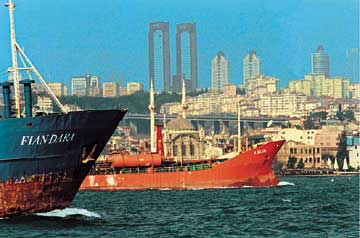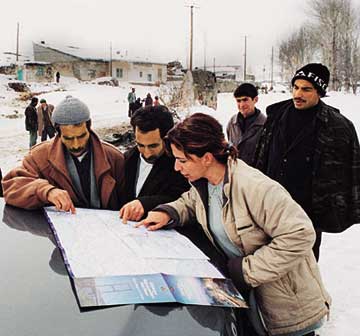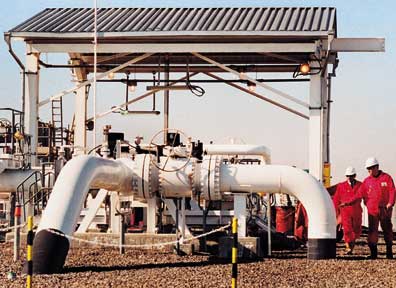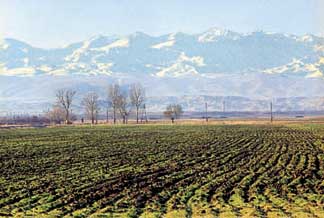|

Spring 2003 (11.1)
Pages
74-79
BTC Section - Pipeline Construction Begins
Beginning
the Journey Westward

Above: Winter conditions near Erzurum in eastern
Turkey. Pipeline construction must wait until the snow has melted.
This April, the eagerly
awaited Baku-Tbilisi-Ceyhan (pronounced jey-HAN) (BTC) oil pipeline
will move one more step closer to reality with the start of construction
at sites in Azerbaijan, Georgia and Turkey along the 1,760-km
route. It has been more than 10 years since the idea was first
proposed.
For the past nine months, the efforts of the BTC consortium have
been focused on planning: creating a project team, carrying out
preliminary environmental and social impact assessments, designing
the pipeline, raising financing, acquiring land, mobilising contractors,
hiring and training workers, defining health, safety and environmental
standards and ensuring that pipe was ordered, manufactured to
specification and delivered on time.
  Left: A key environmental benefit offered
by the BTC project is reduced growth in the future volume of
tanker traffic having to navigate the narrow and congested Turkish
Straits in the world heritage city of Istanbu, Turkey. Left: A key environmental benefit offered
by the BTC project is reduced growth in the future volume of
tanker traffic having to navigate the narrow and congested Turkish
Straits in the world heritage city of Istanbu, Turkey.
With most of these efforts
firmly on track, the spotlight has now shifted to the complex
practical and technical challenges involved in actually laying
a pipeline that will cross three countries, bisect some of the
more isolated and earthquake-prone regions to be found in Europe
or Asia, rise to a height of 2,800 metres and stretch as far
as the distance from London to Gibraltar or from New York to
Miami.
Construction of any pipeline is a sequential process involving
a number of distinct operations undertaken by specialised and
general machinery that is known as the "construction spread."
Within each spread there are eight or nine teams, each doing
different tasks. A typical sequence of activities includes surveying,
preparing the land, stringing out the pipeline sections along
the route, excavating the trench, welding and laying the pipeline,
backfilling the trench with soil, and reinstating the land as
close as possible to its original condition.
Beginning in April 2003, at least one construction spread will
be active at any given time in each country, supported by special
section crews that will be responsible for work at hundreds of
river crossings and other places requiring specialised installation
equipment and techniques.
In Azerbaijan, one spread will start at the Sangachal terminal
on the shores of the Caspian Sea and then move in a westerly
direction to the border of Georgia 442 km away. Much of the terrain
is flat and semi-arid. That section of the route is expected
to be completed in about 12 months.
In Georgia the 248 km-long corridor bisects flat terrain for
two-thirds of the way before moving through a zone that stretches
nearly 100 km across a region notable for its remoteness, poor
weather, height (at some points the route rises above 2,500 metres)
and hard rock conditions.
  Left: Typical scene in eastern Anatolia. Left: Typical scene in eastern Anatolia.
In Turkey, which accounts
for about 60 percent of the pipeline corridor (1,070 km), half
of the route goes through uplands above a height of 1,500 metres.
Weather conditions could be a problem here in winter - not to
mention the route must also move across two of the world's most
active earthquake zones.
Vast quantities of pipe will be used-39,000 sections of pipe
each 11.6 metres long in the Azerbaijan section alone. All the
pipes needed for Azerbaijan and Georgia are being manufactured
in Japan by Sumitomo before being covered in a special protective
coating in Malaysia. Transporting these pieces by sea to the
region will take nearly seven months, with each vessel carrying
enough pipe to cover a 25 - to 30-km section of the route.
The first actual laying of the pipe is scheduled for June 2003.
Depending on local conditions, an average of 1,000-1,500 metres
of pipe will be laid per spread, per country, per day. The period
between initial excavation and the reinstatement of right of
way across the pipeline corridor is expected to take between
two and three months. Reinstatement will include the removal
of all construction facilities, such as workers' camps, pipe
storage yards and temporary access roads.
At full capacity, the line will transport up to one million barrels
of oil a day. Seven intermediate pump stations will be built
- one in Azerbaijan, two in Georgia and four in Turkey, where
a pressure reduction station will also be located. Around 100
block valve stations will be installed to improve safety and
ease maintenance. The line will use several pipe diameters, varying
between 34 and 46 inches. These pipes are protected against external
corrosion by a three-layer, high-density polyethylene coating.
"This is a huge project by any standard," says Phil
Allison, Technical Director of the BTC Company. "The overall
environment is difficult and the timeframe is very tight. It's
not an easy job, and we're taking a big step forward in several
ways, especially in terms of training, safety and care of the
environment."
  Left: Typical scene in eastern Anatolia. Left: Typical scene in eastern Anatolia.
Add the overriding need
for tight security and the best possible relationships with hundreds
of rural communities along the route, and the scale of the challenge
is clear that the BTC construction crews are facing as they begin
work. For the moment, the emphasis is squarely on getting a hugely
complex organisation working safely and efficiently to its full
potential.
Acquiring the Land
Rights
The process of acquiring about 6,000 hectares of land needed
permanently or temporarily to permit the building of the BTC
pipeline began towards the end of 2001. Since then, much progress
has been made, but much still remains to be accomplished.
No one will be forced to leave their homes. However, an estimated
35,000 individual landowners or users, and more than 22,000 parcels
of land, will be affected by the land acquisition programme.
Under the terms of the Intergovernmental Agreement (IGA) and
Host Government Agreements (HGAs), compensation will be paid
to everyone. An appeals system, involving national courts, if
necessary, has been built into the procedures. The precise terms
will vary, reflecting differences in land ownership laws and
customs in each of the host countries.
No project of this scale or complexity has been attempted in
the region before. Land reform is in process in Azerbaijan and
Georgia, and the land market in these countries has not developed
very much yet, making it a complex task to determine compensation.
In Turkey, ownership has sometimes proved hard to establish as
some landowners live in cities or abroad and many of the land
parcels have multiple owners. In addition, land along the length
of the route is being classified according to its potential future
value as well as its current agricultural yields.
Despite these challenges, significant progress has been recorded
in the past 15 months. During this period, land acquisition teams
have been recruited and trained in each country and comprehensive
land inventories have been drawn up.
  Left: Computer generated image of one of
the BTC pumping stations. Left: Computer generated image of one of
the BTC pumping stations.
In Azerbaijan, more
than 4,150 individual agreements and nearly 100 agreements with
municipalities will be signed by the end of the process. In Georgia
the acquisition process was concentrated initially on the difficult
mountainous region to allow construction to begin in the summer
months. In Turkey much of the land along the route is state-owned.
In the areas where it is not, a major drive is now underway to
determine legal title.
As of March 2003, approximately 85 percent of the individual
land lease agreements needed in Azerbaijan, and 50 percent of
those in Georgia had been settled. Most of the compensation -
which will be paid to recipients free of taxes and government
or legal fees - is expected to be made by mid-2003 directly through
the various national banking systems.
Once each construction phase is completed along the route, and
the land above the pipe reinstated to its original condition,
the landowner or user will be able to farm the corridor above
the line.
On average, the pipeline will be buried at a depth of one metre
below the surface. Shallow-rooted crops and shrubs will be permitted,
but there will be restrictions on tree-planting, deep excavation
and ploughing. No structures will be permitted to be built close
to the pipeline corridor. The BTC Company will retain control
of the corridor during the entire construction phase to permit
access for pipeline testing and commissioning.
Enhancing Safety
Approximately 50,000 vessels a year navigate the narrow stretch
of water known as the Turkish Straits, which bisect the city
of Istanbul and link the Black Sea to the Sea of Marmara and
eventually the Mediterranean. In addition to the tankers and
ships that transit the 31-km-long Straits, there are ferries,
fishing boats, pleasure boats and tourist cruisers, which jostle
for space in the narrow waters.
  Left: BTC land acquisition teams meeting
villagers in eastern Turkey. Left: BTC land acquisition teams meeting
villagers in eastern Turkey.
During the last 24 years
more than 300 accidents have been documented in the Bosphorus,
resulting in about 100 deaths.
Two major oil spills took place in 1979 and 1994. In 2002 approximately
910 million barrels of oil - crude and refined products - passed
through the Straits. With the growth of oil production in Russia,
Azerbaijan and Kazakhstan, this figure will certainly increase
if nothing changes.
In 1994 rules were drawn up to deal with this situation including
a mandate related to the vessels' movements according to their
length. However, collisions are still averaging about three a
year, and a large number of vessels transit without proper insurance.
Since the collapse of the Soviet Union, more nations are using
the Bosphorus, making it harder than ever to get the broader
agreement necessary to improve safety, given the status of the
Turkish Straits as an international waterway.
Constructing the BTC pipeline is now seen as one solution of
what must be a multi-faceted response to this situation. By 2008,
when the pipeline is working at full capacity, one million barrels
of oil a day will be flowing through the line to the Ceyhan terminal
- the equivalent of several tanker transits a day through the
Straits. Over the course of the 40-year design life of the BTC
pipeline, this number will add up to around 30,000 transits,
depending on the volume of oil actually moved by the pipeline
and the application of regulations governing the size of vessels
and number of shipping movements permitted through the Straits.
At the same time, the BTC project is acting as a catalyst for
efforts to develop an integrated oil spill response capability
in the Caspian and Black Sea regions. According to a study commissioned
by a consortium of oil companies, including BP, no quick fixes
are possible. "The oil spill risks in the region are significant
today and will increase," observes Study Manager, Peter
Taylor of IPIECA (International Petroleum Industry Environment
Conservation Association). "A major incident could cause
both short- and long-term disruption across the oil industry
and throughout the region."
  Left: Pipelines emerge from the ground at
pumping stations, where access is provided for devices which
travel through the line for maintenance and inspection. Left: Pipelines emerge from the ground at
pumping stations, where access is provided for devices which
travel through the line for maintenance and inspection.
As a result, the study
has recommended 22 specific actions based on ideas to promote
and improve cooperation between governments, international organizations
and the oil industry in the region. Implementing these recommendations
over five years is likely to cost around $6 million.
Financing the Pipeline
Finding the money to fund the Baku-Tbilisi-Ceyhan pipeline has
turned into a global initiative involving scores of international
financial institutions (IFIs) and commercial banks from around
the world. In an unusual move that reflects its confidence in
the viability of the project, the BTC consortium has decided
to provide the necessary funds to allow construction work to
progress to the end of 2003 before all the loans are finalised.
The Baku-Tbilisi-Ceyhan project is commercially robust, and the
BTC Company expects to raise the financing it needs at commercial
rates reflecting the current risk premium for investing in the
region. No bank or other financial institution will be subsidising
the link.
The actual construction costs of the project - around $3 billion
- will be underpinned by more than $1 billion provided by the
sponsoring companies in the form of equity investment. The balance
is expected to come in the form of debt from a variety of IFIs
together with shareholder loans. All told, about 30 percent of
the funds will be provided on equity terms and 70 percent on
debt terms.
  Left: BTC will traverse agricultural land
like this in western Azerbaijan. Left: BTC will traverse agricultural land
like this in western Azerbaijan.
According to John Wingate
of Statoil, who heads the drive by the BTC Company to raise financing
for the project, the immediate priority is to reach common terms
with all potential lenders. After that, the environmental information
public disclosure process of the IFI is expected to continue
for several months. The governing boards of these agencies will
then vote on the specific financing proposals.
Despite the complexity, BTC shareholders are optimistic that
the financing can be completed on schedule. In the words of David
Woodward, President of BP Azerbaijan: "This is one of the
most complicated export financing projects ever undertaken. But
we're very confident that everything will be finalized by the
end of the year."
A wide variety of groups are involved in this process. The first
group includes the IFIs of the International Finance Corporation
(the IFC is an arm of the World Bank) and the European Bank for
Reconstruction and Development (EBRD) which have specific mandates
to support and stimulate development. The second group involves
national ECGAs (Export Credit Guarantee Agencies) such as the
U.S. Export-Import Bank and Britain's Export Credit Guarantee
Department, which effectively underwrite lending by commercial
banks.
A third group is made up of specialist organizations such as
OPIC (Overseas Private Investment Corporation - an independent
U.S. government agency) - and its Japanese equivalent, the Nippon
Export and Investment Insurance (NEXI), which provide political
risk insurance to enhance commercial activity by their national
companies or banks. Finally, there are commercial banks. At the
start of construction in April 2003, four banks are leading negotiations
with the BTC consortium, but as many as 30 may eventually lend
to the project.
  Left: Jan Leschly, Caspian Development Advisory
Panel (CDAP). Left: Jan Leschly, Caspian Development Advisory
Panel (CDAP).
Why is the BTC Company
raising money through sources that might end up being more expensive
than normal for infrastructure projects of this sort? One reason
is that the involvement of IFIs such as the EBRD and the IFC,
with their stringent environmental and ethical disclosure requirements,
will provide further assurance that the BTC project is carried
out to the highest standards. Also, the consortium desires to
operate as a single entity. In Wingate's words: "It's a
way of enabling maximum participation by a number of important
state-owned companies in the project.
Exporting Gas from
the Region
In a decision made at the end of February, which had wide significance
for the BTC project, seven partners in the Shah Deniz gas and
condensate field in the Azerbaijan sector of the Caspian Sea
agreed to commit a total of $3.2 billion to the construction
of another East-West energy corridor to Turkey and beyond.
The new company, known as the South Caucasus Pipeline Company
(SCPC), is comprised of the same seven partners as the Shah Deniz
consortium: BP (25.5%), Statoil (25.5%), SOCAR (10%), LUKAgip
(10%), NICO (NaftIran Intertrade Co.) (10%), TotalFinaElf 10%
and TPAO (Turkey's State Oil Company) (9%). SCPC will have overall
control of the pipeline. BP will be responsible for construction
and operation of the SCPC facilities, whereas Statoil will take
charge of the commercial affairs and administration.
This development, known as Stage 1, includes an offshore platform,
wells and subsea pipelines in the Caspian, onshore gas and condensate
processing facilities at the Sangachal terminal, and a 690 km
long, $900 million gas pipeline from the terminal near Baku via
Georgia to the Turkish border.
The pipeline is to be constructed along the same route as the
BTC oil pipeline in order to minimise the environmental and social
impact of the two projects and to achieve capital and operational
cost-savings. Construction is scheduled to commence in 2004 and
will be completed in time to deliver First Gas to Turkey in 2006.
Environmental and Social Impact Assessments (ESIAs) for the Azerbaijan
and Georgian sections of the SCP route, as well as for the related
offshore/onshore facilities, have already been conducted and
approved. Safety will be a top priority and an important criterion
in the selection of contractors.
During construction, the SCP project will create 4,200 direct
local jobs and an additional 1,300 jobs related to construction
of the onshore and offshore facilities. A $7.5 million community
investment programme will be implemented in Azerbaijan and Georgia
as well as a $4 million environmental investment programme.
Checking the Standards
A number of key safeguards have been built into the BTC project
to ensure that it sets new standards for responsible development.
Among the most important is the creation of an independent external
grouping, the Caspian Developments Advisory Panel (CDAP), with
a three-year remit to provide objective advice on the pipeline's
economic, social and environmental impact on the three host countries
- and in particular on areas closest to the route.
Chaired by Jan Leschly, who is chairman and partner of Care Capital
and former Chief Executive of SmithKline Beecham, the four-person
panel is empowered to comment on all oil and gas developments
broadly related to the BTC project, including the Azeri-Chirag-Gunashli
(ACG) oilfield, the Shah Deniz gas field and the South Caucasus
gas export pipeline (SCP).
Danish-born Jan Leschly is a member of the Board of Directors
of American Express, Viacom Inc. and the Maersk Group. Care Capital
is a $100 million life sciences venture fund. Other panel members
include Jim McNeill, a Canadian diplomat and policy advisor on
environmental and energy issues who is Chairman of the International
Institute for Sustainable Development and a former member of
the UN's World Commission on Environment & Development; Stuart
Eizenstat, Deputy Secretary of the Treasury during the Clinton
administration; and Mohamed Sahnoun, a former ambassador and
adviser to the President of Algeria and member of the UN World
Commission on Environment & Development who is now associated
with the International Development Research Centre.
During the first half of 2003, the panel is scheduled to visit
all three countries hosting the pipeline, including locations
along the route, and to consult with community leaders, government
officials, representatives of non-governmental organizations
and others as it sees fit. It will use its first report later
this year as a baseline for follow-up work to be done in the
next two years.
The panel will be funded by BP, which operates BTC, ACG (Azeri,
Chirag, deep-water Gunashli) and Shah Deniz. It will have its
own Secretariat, be assisted by local representatives in each
country and report directly to Lord Browne, Chief Executive Officer
of BP. Its reports will be made public together with BP's responses.
The panel can be contacted via e-mail at CDAP@caspsea.com.
Back to Index
AI 11.1 (Spring 2003)
AI Home
| Search | Magazine
Choice
| Topics
| AI Store | Contact us
Other Web sites
created by Azerbaijan International
AZgallery.org | AZERI.org | HAJIBEYOV.com
|